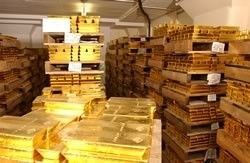Gold Prices Retreat as European Stocks Gain

Gold fell more than 1 percent on Wednesday, extending the previous day's hefty losses, as rising equities diverted some interest from the precious metal, and as investors remained wary of buying into the market after its recent sharp volatility.
Spot gold was down 1.3 percent at $1,599.70 an ounce at 0932 GMT. It shed 2 percent of its value late on Tuesday to drop back below $1,600 an ounce, as investors sold stocks of the metal to cover losses on other markets as stocks slid.
Silver also fell nearly 5 percent to a session low at $28.45 an ounce. It was later at $28.62, down 4.3 percent.
Gains in European shares on Wednesday, led by banks after European finance ministers agreed to safeguard lenders, did little to reverse the previous day's losses as buyers spooked by recent sharp price swings stayed away from precious metals.
My sense is that gold is a bit like silver after its collapse (in May) from almost $50 to around $35, said Deutsche Bank analyst Michael Lewis. It was incredibly erratic but with quite a stable performance over about six to eight weeks.
I don't there is going to be much clear direction for gold at the moment, he added. To some extent the market is just a bit broken, and needs to repair itself... the strength that we saw (earlier this year) is going be difficult to repeat.
Gold fell 20 percent last month from its early record high at $1,920.30 as stock market volatility picked up, with investors shaken by the worsening euro zone debt crisis.
European finance ministers agreed on Tuesday to safeguard banks as doubts grew about whether a planned second bailout package for debt-laden Greece would go ahead.
The growing prospect of a Greek debt default has stoked fears of a banking crisis in Europe that would aggravate the global economic slowdown. This in turn has hurt stocks, leading to heightened volatility, with a knock-on effect on gold.
Separating itself from negative influences is by no means a straightforward endeavor for gold and volatile price action is clearly going to persist, said UBS in a note.
Yesterday's moves highlight the difficulty of making sense of the gold market in the current shaky environment.
U.S. gold futures for December delivery were down $14.50 an ounce at $1,601.50.
CURRENCIES FLUCTUATE, COMMODITIES CLIMB
The currency markets also remained volatile, with the euro slipping and vulnerable to more selling if European policymakers are not seen to be making progress on discussion to recapitalize struggling banks.
While the single currency neared a 9-month low against the dollar, the U.S. unit also fell 0.6 percent against a basket of currencies .DXY as investors locked in profits.
Other commodities rebounded, with oil prices up around $2 a barrel after Tuesday's slide, and industrial metals like copper and aluminum climbing.
Spot platinum was down 2.1 percent at $1,433.99 an ounce, while spot palladium was up 0.1 percent at $550.22 an ounce.
Although palladium ran into buying after prices hit their lowest in a year on Tuesday, platinum fell to a fresh 22-month low on Wednesday and rhodium its weakest in two years as growth worries hurt industrial precious metals.
The precious metals appear oversold, but changes in risk appetite, with the financial markets moving rapidly from risk-on to risk-off sentiments, are helping to create volatile price swings, said HSBC in a note.
The near-term price momentum appears lower, but in the case of the platinum group metals, lower prices could threaten mine production. This should help stabilize prices.
Lower gold prices, in addition to stimulating emerging market demand, may encourage official sector demand, it added. This leads us to look for prices of gold and the other precious metals to bottom out in the near term.
© Copyright Thomson Reuters {{Year}}. All rights reserved.






















